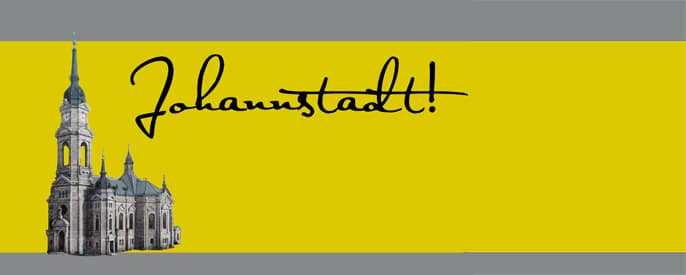This site is available in multiple languages: Deutsch, Русский, عربي.
Heading from Trinitatisplatz, walk down Gerokstraße toward the city and turn right into Lili-Elbe-Straße in front of the Johannstadt rescue center. Positioned directly behind the rescue center is the second location along the historical walking tour: Johanngarten.
Before 1945: Kamelienstraße and Carolahaus
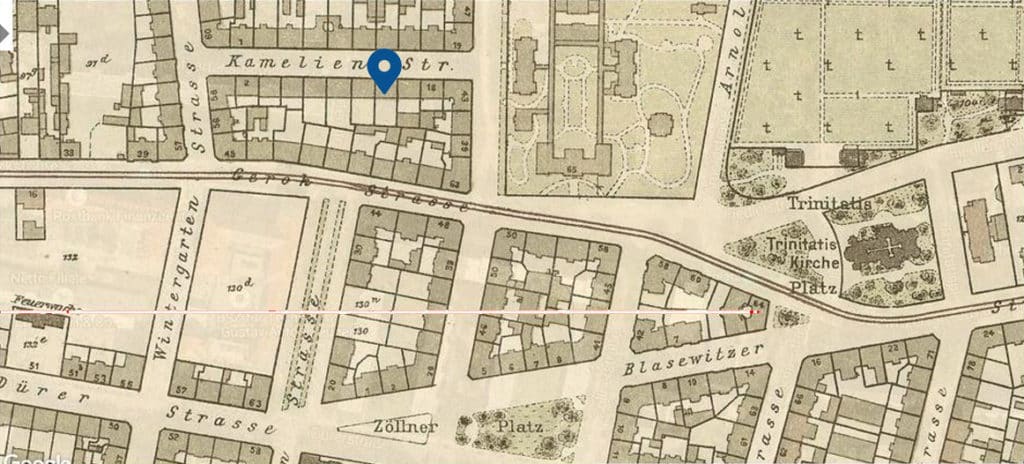
Kamelienstraße
Kamelienstraße, laid in 1876, once ran alongside this panel’s location and was characteristic of a residential street from the first days of Johannstadt. The homogeneous development along either side was devoted almost exclusively to residential purposes, with the occasional small business in the rear courtyard. After all the homes on Kamelienstraße fell victim to the 1945 bombardment, the road was passed over for redevelopment. Today, part of the street has been incorporated into Hopfgartenstraße.
The area had once belonged to the large Hopfgarten estate, later Elisens Ruhe. At the beginning of the 19th century, the settlement was split up several times over. One part was acquired by Lüdicke Florist and Nursery, which among other things was famous for its cultivation of camellias. In 1859, Lüdicke Landscapers set up a winter garden, which became a botanical attraction thanks to its wealth of camellias. After the garden was forced to close in 1878, homes were built upon the grounds. The names Wintergartenstraße and Kamelienstraße are throwbacks to the area’s botanical heritage.
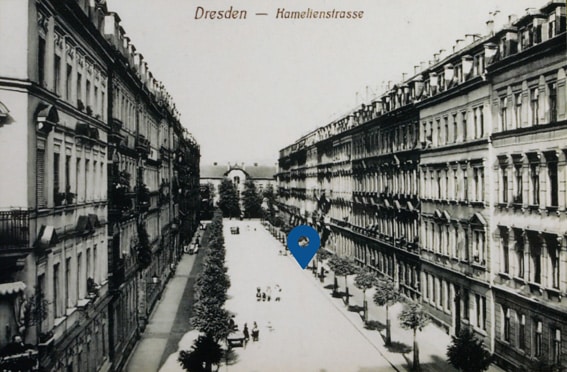
Kamelienstraße connected Wintergartenstraßse with Stephanienstraße at the Carolahaus. This panel is oriented exactly as on shown on the postcard, with a view of the Carolahaus.
Find more information on the history of Kamelienstraße here.
Carolahaus
The Carolahaus was the first public hospital in Dresden’s Johannstadt. It was opened in 1878 by the Albertverein, which ran it as a hospital into the 1930s. The establishment bore the name Carola von Wasa-Holstein-Gottorp, the last queen of Saxony. The hospital’s finances worsened after the First World War, which forced the Albertverein to sell it to the city of Dresden in 1920. In 1934, a school for the Sturmabteilung (SA) moved into the Carolahaus. With the outbreak of the Second World War, the building was repurposed as a military hospital. In February 1945, the Carolahaus fell victim to the air attacks on Dresden and was completely destroyed.
Find more information on the Carolahaus here.
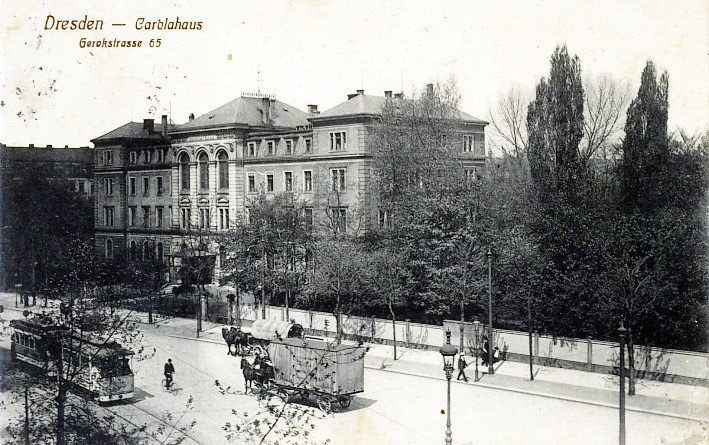
After 1945: Plattenwerk and Johanngarten: a somewhat different green space
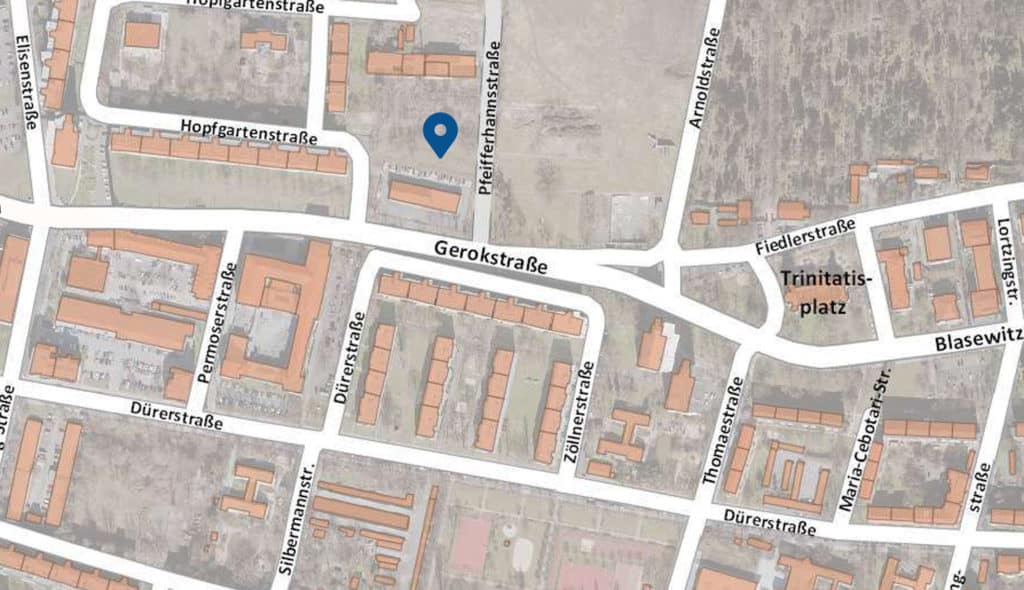
Plattenwerk Johannstadt
In 1958, after demolishing what remained of the Carolahaus, one of the GDR’s first Plattenwerke (concrete slab factories) arose in its place. The factory devoted seven hectares to the fabrication of concrete slabs for socialist residences. To that end, thousands of tons of rubble from center city buildings destroyed in 1945 were recycled on site and utilized once more as building components in concrete slabs. Until its closure in 1990/91, the factory produced material for tens of thousands of new apartments in Dresden, Riesa and Coswig, whereby it eventually started specializing in exterior wall slabs.
After German reunification, the grounds fell into disuse. The city of Dresden sold the empty lot to a private investor. A small portion of the demolition material was acquired by architect Ruari O’Brien for the museum project Betonzeitschiene. The museum opened in 2004, but was forced to shut down again in 2007 after its land use permit expired.
Find more information on the history of the Plattenwerk here.
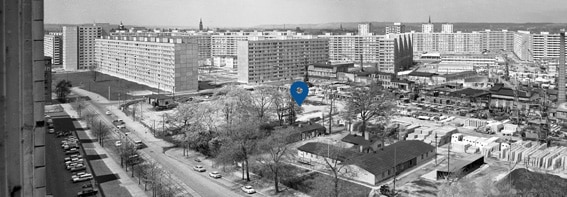
Johanngarten
Since 2017, Johannstadt has had a new neighborhood park – the Johanngarten. The result of intensive citizen involvement, this small park for all ages was created on the grounds of the former Plattenwerk, complete with the original construction materials. The three rooms of a WBS apartment (social housing) builds the thematic leitmotif. In the living room, there is a complete lounge suite made of concrete; in the bedroom, a concrete double bed. In the kitchen, a colorful concrete ratatouille is bubbling in a pot, while the balcony encourages relaxation and—panel—reading. In the children’s room, as per the residents’ wishes, there is a refuge. Years marked on the floor denote the child’s growth into an adult.
The bordering grassy fields (formerly Kamelienstraße) invite you to relax, kick about and sunbathe to your heart’s delight. The linear path through the park is made up of concrete slabs, some of which come from the space in front of the Dresdner Kulturpalast. The privacy barriers were decorated during the construction phase by the neighborhood youth. In 2016, Bönischplatzfest visitors selected the name Johanngarten from a list of suggestions.

Text: Matthias Erfurth, Matthias Kunert, Henning Seidler
Editorial deadline: April 2017
